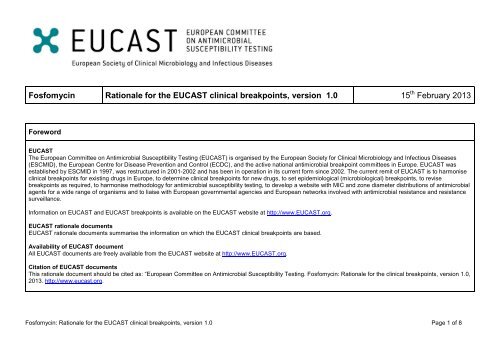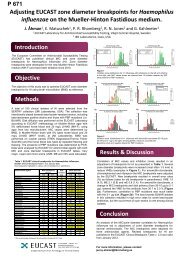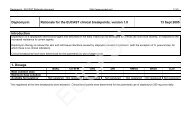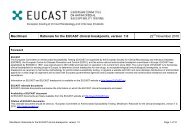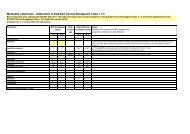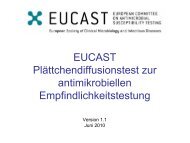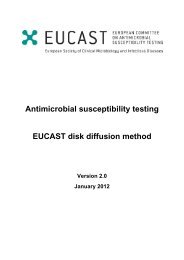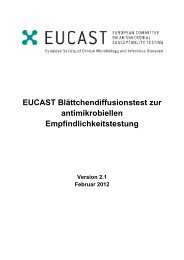Fosfomycin - eucast
Fosfomycin - eucast
Fosfomycin - eucast
- No tags were found...
Create successful ePaper yourself
Turn your PDF publications into a flip-book with our unique Google optimized e-Paper software.
<strong>Fosfomycin</strong> Rationale for the EUCAST clinical breakpoints, version 1.0 15 th February 2013ForewordEUCASTThe European Committee on Antimicrobial Susceptibility Testing (EUCAST) is organised by the European Society for Clinical Microbiology and Infectious Diseases(ESCMID), the European Centre for Disease Prevention and Control (ECDC), and the active national antimicrobial breakpoint committees in Europe. EUCAST wasestablished by ESCMID in 1997, was restructured in 2001-2002 and has been in operation in its current form since 2002. The current remit of EUCAST is to harmoniseclinical breakpoints for existing drugs in Europe, to determine clinical breakpoints for new drugs, to set epidemiological (microbiological) breakpoints, to revisebreakpoints as required, to harmonise methodology for antimicrobial susceptibility testing, to develop a website with MIC and zone diameter distributions of antimicrobialagents for a wide range of organisms and to liaise with European governmental agencies and European networks involved with antimicrobial resistance and resistancesurveillance.Information on EUCAST and EUCAST breakpoints is available on the EUCAST website at http://www.EUCAST.org.EUCAST rationale documentsEUCAST rationale documents summarise the information on which the EUCAST clinical breakpoints are based.Availability of EUCAST documentAll EUCAST documents are freely available from the EUCAST website at http://www.EUCAST.org.Citation of EUCAST documentsThis rationale document should be cited as: “European Committee on Antimicrobial Susceptibility Testing. <strong>Fosfomycin</strong>: Rationale for the clinical breakpoints, version 1.0,2013. http://www.<strong>eucast</strong>.org.<strong>Fosfomycin</strong>: Rationale for the EUCAST clinical breakpoints, version 1.0 Page 1 of 8
Introduction<strong>Fosfomycin</strong> is an organic phosphonate agent. It is rapidly bactericidal and inhibits cell wall synthesis by irreversibly inhibiting enol-pyruvyl transferase, which catalyzesthe first step in the biosynthesis of peptidoglycan.<strong>Fosfomycin</strong> is a broad spectrum agent which is particularly active against Escherichia coli and some other Enterobacteriaceae. It also shows good activity againstStaphylococcus aureus, including methicillin resistant S. aureus and most coagulase-negative staphylococci. It is less active against Enterococcus spp andPseudomonas aeruginosa, which show a wide range of MIC values among isolates, Resistance may be related to reduced uptake of fosfomycin or plasmid-mediatedenzymatic inactivation of fosfomycin. In vitro, resistant mutants arise at a frequency of 10 -4 to 10 -5 . In vivo resistance is increasingly recognised, particularly in ESBLproducingE. coli. In critically ill patients it is most commonly used in combination therapy.In some countries fosfomycin has been used to treat patients with various infections including pneumonia and other lower respiratory infections, ear, nose, and throatinfections, eye infections, osteomyelitis, meningitis, surgical infections, obstetric and gynecological infections, arthritis, septicemia, peritonitis, cervical lymphadenitis ,diabetic foot infections and typhoid fever.1. DosageBSAC CA-SFM CRG DIN NWGA SRGAMost common dose -Maximum dose schedule -4 g x 3 iv4h infusion8 g x 3 iv4h infusion- 3 g x 3 iv - -- 5g x 3 iv - -Available formulations - iv - iv - -<strong>Fosfomycin</strong>: Rationale for the EUCAST clinical breakpoints, version 1.0 Page 2 of 8
2. MIC distributions and epidemiological cut-off (ECOFF) values0.002 0.004 0.008 0.016 0.032 0.064 0.125 0.25 0.5 1 2 4 8 16 32 64 128 256 512 ECOFFAcinetobacter spp 0 0 0 0 0 0 0 1 0 1 1 0 0 7 6 21 31 18 0 NDCitrobacter spp 0 0 0 0 0 6 38 2 2 2 1 0 0 0 0 0 0 0 0 NDEnterobacter aerogenes 0 0 0 0 0 0 0 0 0 0 1 2 7 19 32 13 6 0 0 NDEnterobacter cloacae 0 0 0 0 0 0 0 0 0 0 3 23 13 18 24 75 105 0 0 NDEnterobacter spp 0 0 0 0 0 0 0 0 8 14 6 11 29 69 35 16 18 21 5 NDEnterococcus faecalis 0 0 0 0 0 0 0 0 2 2 0 1 17 98 959 502 64 9 12 NDEnterococcus faecium 0 0 0 0 0 0 0 0 1 0 0 0 0 3 54 373 52 0 0 NDEnterococcus spp 0 0 0 0 0 0 0 1 0 0 0 0 8 46 31 6 3 1 0 NDEscherichia coli 0 0 0 0 1 1 54 74 513 890 922 1013 801 483 243 89 33 0 0 8Haemophilus influenzae 0 0 0 0 0 0 0 0 0 37 5 5 0 0 1 1 1 0 0 NDKlebsiella spp 0 0 0 0 0 0 6 3 27 50 47 73 138 147 127 64 25 16 35 NDProteus mirabilis 0 0 0 0 0 0 6 15 89 188 200 199 242 100 78 88 89 34 0 8Proteus spp 0 0 0 0 0 0 0 0 17 23 30 20 37 37 36 29 14 16 23 NDProvidencia spp 0 0 0 0 0 0 1 2 2 2 24 15 5 1 2 0 0 0 0 NDPseudomonas aeruginosa 0 0 0 0 0 0 0 0 8 4 32 46 58 100 174 350 216 14 22 NDSerratia marcescens 0 0 0 0 0 0 0 0 3 7 20 51 30 36 7 6 4 0 0 NDShigella spp 0 0 0 0 0 0 0 0 4 63 101 8 6 0 0 3 0 0 0 NDStaphylococcus aureus 0 0 0 0 0 0 2 2 91 226 389 366 465 309 121 50 25 2 3 32Staphylococcus epidermidis 0 0 0 0 0 0 0 0 49 116 135 95 141 100 30 47 182 1 0 NDStaphylococcus saprophyticus 0 0 0 0 0 0 0 0 0 0 0 2 0 2 7 23 5 10 0 NDStreptococcus pneumoniae 0 0 0 0 0 0 0 0 0 0 0 16 32 6 3 0 0 0 0 NDStreptococcus pyogenes 0 0 0 0 0 0 0 0 0 0 1 0 1 3 25 20 0 0 0 NDThe table includes MIC distributions available at the time breakpoints were set. They represent combined distributions from multiple sources and time periods. Thedistributions are used to define the epidemiological cut-offs (ECOFF) and give an indication of the MICs for organisms with acquired or mutational resistance mechanisms.They should not be used to infer resistance rates. When there is insufficient evidence no epidemiological cut-off has been determined (ND).<strong>Fosfomycin</strong>: Rationale for the EUCAST clinical breakpoints, version 1.0 Page 3 of 8
3. Breakpoints prior to harmonisation (mg/L) S< R>BSAC CA-SFM CRG DIN NWGA SRGA CLSIGeneral breakpoint- 32/32 - 64/64 - - -Species specific breakpoints:Enterobacteriaceae 32/32Pseudomonas spp. 32/32Acinetobacter spp.Staphylococcus spp. 32/32Streptococcus spp.Alpha haemolytic streptococciStreptococcus pneumoniaeEnterococcus spp. 32/32Haemophilus influenzaeMoraxella catarrhalisCorynebacteriaNeisseria meningitidisNeisseria gonorrhoeaePasteurella multocidaAnaerobes, Gram-positiveAnaerobes, Gram-negativeCampylobacter spp.Helicobacter pylori<strong>Fosfomycin</strong>: Rationale for the EUCAST clinical breakpoints, version 1.0 Page 4 of 8
4. PharmacokineticsDosage4 gBioavailabilityCmax (mg/L) 132Cmin (mg/L) 4.1Total body clearance (L/h)T ½ (h), mean (range) 2.25AUC24h (mg.h/L) 167.9-290.8Fraction unbound (%) >95%Volume of distribution (L/kG) 0.32-0.38Comments• Cells are left empty when data are not readily available. Two values are given where references differ.• Fraction recovered in urine after fosfomycin IV administration is more than 85% in 12 hReferences• Goto M. et al. Antimicrob Agents Chemother 1981; 20: 393-397.• Bergogne-Berezin E. <strong>Fosfomycin</strong> and derivatives. In Antimicrobial Agents. Bryskier A (ed). 2005: pp.972-982.<strong>Fosfomycin</strong>: Rationale for the EUCAST clinical breakpoints, version 1.0 Page 5 of 8
5. PharmacodynamicsEnterobacteriaceaefAUC/MIC for bacteriostasis25 (serum)3994 (urine)fAUC/MIC for 2 log reduction -fAUC/MIC from clinical data -CommentsReferences• Patel SS et al. Drugs 1997; 53: 637–56• Bergongne-Berezin. E. <strong>Fosfomycin</strong> and derivatives. In Antimicrobial Agents. Bryskier (ed). 2005, pp. 972-982.6. Monte Carlo simulations and PK/PD breakpointsNot available.7. Clinical dataData relating susceptibility to outcome for intravenous fosfomycin used alone are not available. When fosfomycin is used in combination with other antibiotics to treatpatients with various Gram-positive and Gram-negative infections including pneumonia and other respiratory infections, osteomyelitis, meningitis, ear, nose, and throatinfections, surgical infections, obstetric and gynecological infections, arthritis, septicemia, peritonitis, cervical lymphadenitis, eye infections, diabetic foot infections andtyphoid fever, cure rates are around 80-85% (Falagas ME et al. Clin Infect Dis 2008; 46: 1069-77).<strong>Fosfomycin</strong>: Rationale for the EUCAST clinical breakpoints, version 1.0 Page 6 of 8
8. Clinical breakpointsNon-species-relatedbreakpointsThere is insufficient evidence to set non-species-related breakpoints.Species-relatedbreakpointsBreakpoints were based on pharmacokinetic data, microbiological data and clinical experience.For Enterobacteriaceae and Staphylococcus spp. breakpoints are S ≤32 mg/L / R >32 mg/L.Species withoutbreakpointsPseudomonas spp., Acinetobacter spp., Enterococcus spp. Neisseria spp. and anaerobes were considered poor targets for systemic fosfomycintherapy and for that reason did not receive breakpoints.For S. pneumoniae, Haemophilus influenzae and Moraxella catarrhalis there was considered to be insufficient evidence to set breakpoints.Clinical qualificationsFor severe infections fosfomycin is always used in combination with a β-lactam, aminoglycoside, fluoroquinolone or glycopeptide antibiotic.Anecdotal evidence suggests that infections caused by wild type P. aeruginosa isolates (ECOFF WT ≤128 mg/) may be treated withcombinations of fosfomycin and other agents.Dosage Breakpoints apply to a dosage of 4-8 g x 3.Additional commentIn vitro susceptibility testing with fosfomycin requires the addition of glucose-6-phosphate either to the medium or to the disk or gradient strip.For agar or broth microdilution MIC determination the medium should be supplemented with 25 mg/L of glucose-6-phosphate. In addition tofosfomycin, disks for diffusion susceptibility testing should contain 50μg of glucose-6-phosphate and gradient MIC strips should contain 25μg ofglucose-6-phosphate.<strong>Fosfomycin</strong>: Rationale for the EUCAST clinical breakpoints, version 1.0 Page 7 of 8
9. EUCAST clinical MIC breakpointsAll EUCAST breakpoints can be found at http://www.<strong>eucast</strong>.org.10. Exceptions noted for individual national committeesNone.<strong>Fosfomycin</strong>: Rationale for the EUCAST clinical breakpoints, version 1.0 Page 8 of 8


